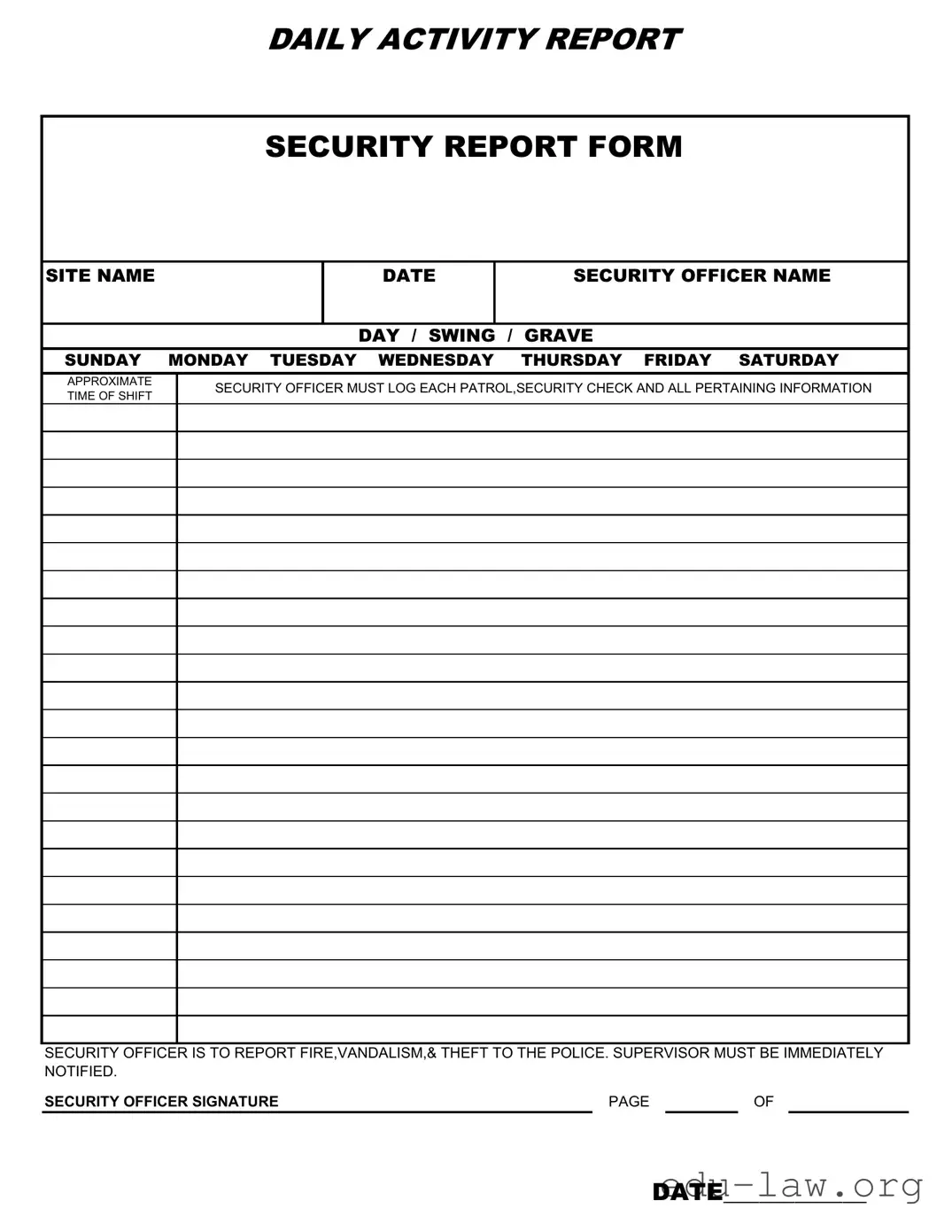The Incident Report is a foundational document often used in various sectors, including security. Like the Security Guard Daily Report, it captures specific events as they occur, ensuring that all relevant details are documented for future reference. Both documents formalize reporting processes, maintaining a clear record of incidents that can later assist in investigations or audits. The Incident Report, however, focuses specifically on singular events such as theft or vandalism, rather than the overall daily activities of security personnel.
The Shift Log is another document that bears similarities to the Security Guard Daily Report. It serves as a record of a security officer's activities during their shift, detailing things like patrols, check-ins, and communications with other personnel. While the Daily Report might summarize the day’s different activities and incidents at a broader level, the Shift Log is typically more granular, showcasing minute-by-minute documentation of actions taken during shifts.
A Patrol Report is essential in many security operations and closely mirrors elements of the Daily Report. This document specifically focuses on the patrols conducted by security officers, detailing areas covered, times of patrols, and any abnormalities noticed during their rounds. While both documents emphasize logging activities, the Patrol Report hones in on the specifics of each patrol route, ensuring accountability and safety on-site.
The Daily Activity Log acts similarly to the Security Guard Daily Report, providing a comprehensive account of all activities conducted by security personnel on a particular day. It includes timestamps and descriptions of each action, aiding in establishing a timeline of events. Both documents serve as a narrative of security presence but differ in structure, with the Daily Activity Log often being more structured and concise in format.
The Security Incident Log is another critical document that supports the need for comprehensive reporting. It functions as a registry for all security-related incidents that occur over a period. Similar to the Daily Report, it captures the specifics of interactions and events, making it an essential reference for security operations management. However, the Security Incident Log is more focused on recording incidents rather than the daily routine of security officers.
The Emergency Response Report is used in situations where security personnel respond to emergencies. It is akin to the Security Guard Daily Report in that it retains details about the incident, responses, and outcomes. While the Daily Report provides a broader view of the daily activities, the Emergency Response Report narrows the focus specifically to emergency situations, detailing actions taken during critical moments.
The Visitor Log is crucial in tracking and managing the movement of individuals within a facility. This document is similar to the Security Guard Daily Report in its function of recording information—who visited, when, and any pertinent details about their entry or exit. While the Daily Report details security activities and incidents, the Visitor Log zeroes in on the presence and movements of guests or personnel, enhancing security protocols by keeping thorough records of who accesses the site.
The Maintenance Report can also relate to the daily duties captured in the Security Guard Daily Report. This document records any maintenance issues observed during the security officer's shift, such as broken locks or safety hazards. Like the Daily Report, the Maintenance Report is crucial for maintaining safety standards. However, its focus is strictly on equipment and facility-related issues rather than overall security operations.
The Access Control Log works alongside the Security Guard Daily Report by maintaining information about entry points and those who have accessed a facility. Both documents emphasize the importance of security by documenting safe practices. However, the Access Control Log is specifically concerned with who enters and leaves, providing a detailed account that can be referenced in case of security breaches or emergencies.
Finally, the Safety Inspection Report shares similarities with the Security Guard Daily Report in terms of documenting conditions within a property. It outlines any safety concerns noticed during inspections, like unclear exit signs or malfunctioning fire alarms. Both reports play critical roles in ensuring safety and security but differ in focus, with the Safety Inspection Report dedicated to adherence to safety protocols, while the Daily Report encompasses overall security activities and incidents.

